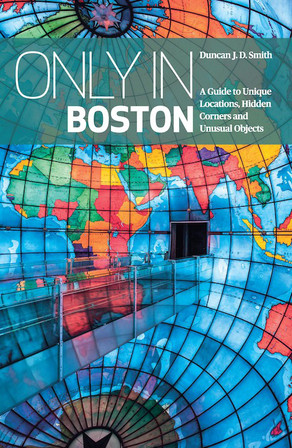by Duncan J.D. Smith

At the end of Marlborough Street, just inside the Public Garden, stands a memorial depicting a doctor holding a cloth and the limp body of a man. An inscription explains that it commemorates the first public use of ether as an anaesthetic. This momentous medical event took place in 1846 at Boston’s Massachusetts General Hospital, or Mass General for short.
Bullfinch Building
The sprawling hospital, the USA’s third oldest, is a 15-minute walk north of the Ether Monument, the city’s West End district. The original building, which opened to the public in 1821, is still standing on Fruit Street and was designed by America’s first professional architect, Charles Bulfinch (1763–1844). Rendered in the Greek Revival-style, it is built from white Chelmsford granite hewn by inmates from the Charlestown prison.
The so-called Bulfinch Building was a carefully considered structure, with advanced features including a central heating system and flushing water closets. Probably the most important element though was the operating theatre. During the 19th century, when hygiene standards were more primitive than today, it was important to admit as much light and air to such spaces. Accordingly Bulfinch placed his theatre at the top of the building. There it was illuminated from above by windows in a copper dome, which also admitted breezes blowing off the Charles River. The seats for onlookers were ranged precipitously along the south wall, affording the best view of the operations carried out below.

No Humbug
Another reason for placing the theatre at the top of the building was undoubtedly to muffle patients’ screams. This was certainly true in the early years, when surgery was performed without anaesthetic. That changed on 16th October 1846, however, when three men made medical history here. Dentist Dr. William T. G. Morton (1819–1868) was invited to perform a public demonstration of the novel use of ether to render a patient insensible to pain. The patient was Edward Gilbert Abbott, a local man with a tumour on his jaw. With the ether administered, Harvard Medical School surgeon Dr. John Collins Warren (1778–1856) removed the tumour without causing Abbott any significant discomfort. Afterwards the usually sceptical Warren quipped, “Gentlemen, this is no humbug”, a reference to the unsuccessful use of nitrous oxide a year earlier, which ended with cries of “Humbug!” after the patient audibly groaned with pain! News of Morton’s successful ‘anaesthesia’, a term coined by Boston poet and physician Oliver Wendell Holmes Sr. (1809–1894), circulated quickly around the world changing medical practice forever.
Egyptian Mummy
The Ether Dome, as the Bulfinch operating theatre is known today, has since been declared a National Historic Landmark. It no longer hosts grisly operations but instead medical lectures and meetings. Undeniably an architectural gem, it is also open to the public. Visitors will see where more than 8,000 operations were carried out between 1821 and 1868, and they can sit where curious onlookers once witnessed them. The names of all the important figures associated with the discovery of ether are inscribed on brass plaques on the seats.

Not surprisingly the Ether Dome contains a teaching skeleton, and a somewhat unnerving collection of early surgical implements. A marvellous painting on the wall depicts a re-enactment of the now-famous 1846 event, with present-day hospital staff wearing period dress. More surprising is the Egyptian mummy in a glass case and a Classical marble statue of Apollo, both of which were given to the hospital as gifts.
Glass Inhaler
Of related interest to the Ether Dome is the Paul S. Russell, MD Museum of Medical History and Innovation, which is located nearby at 2 North Grove Street. Among the many objects of interest is a glass inhaler of the type pioneered by Dr. Morton for the administration of ether. The rooftop garden here is an added perk since it affords sweeping views of Beacon Hill and the State House dome.
Adapted from the book Only in Boston: A Guide to Unique Locations, Hidden Corners and Unusual Objects by Duncan JD Smith (published by The Urban Explorer).
Also in this series by Duncan J.D. Smith:
About the Author
Explorer and travel writer Duncan JD Smith first got the history bug when his grandfather unearthed the grave of a Roman soldier. He opened his own museum aged eleven and went on to study archaeology at Birmingham. After many years in travel publishing, in 2003 he relocated to Vienna, where he writes and publishes his Only In Guides, a series of city guides for independent cultural travellers. Duncan is a Fellow of the Royal Geographical Society. www.duncanjdsmith.com and www.onlyinguides.com.
More about Boston
Boston is also featured in our Spring 2018 issue. With its revolutionary-era history and enviable coastal setting, Boston has long attracted visitors. Enjoy our 14 page feature article by Duncan JD Smith who reveals some of its lesser-known sights.
Find out more about the content of the Spring 2018 issue or purchase a digital copy of the issue for just £3.95.
Don't forget the whole Timeless Travels Collection (24 magazines) is available for just £49.99 - that's just £2.08 each!









Comments